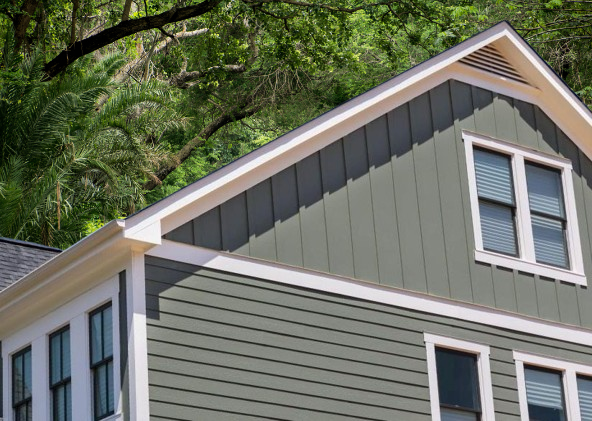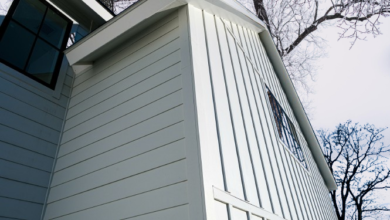T1-11 Siding Alternatives

In the 1980s and 90s, T1-11 siding was the most popular option available. Once installed, the homeowners were enamored with the natural wood finish.
Even though T1-11 siding is inexpensive, readily available, and simple to install, its appeal has substantially decreased in the modern era.
These days, the majority of homeowners would rather look into T1-11 siding substitutes that are stronger and less likely to deteriorate from moisture. I’ve searched the market and found the top 5 T1-11 siding options, which are listed below.
1. The LP SmartSide
This is the market’s greatest substitute for T1-11 siding. T1-11 is constructed out of OSB and plywood, as you may already be aware.
Conversely, LP SmartSide is constructed from engineered wood. The latter is a kind of wood that has been redesigned and engineered to be stronger than its natural counterpart.
In the 1990s, LP SmartSide was first released. And ever since, it has been competitive with T1-11. Although it has a T1-11 appearance, it has remarkable durability and performance.
Indeed, engineered wood has an artificial appearance. However, it still possesses wood’s graceful qualities. In addition, it comes in over ten distinct color options. The fact that LP SmartSide can be painted to enhance the external aesthetics is something I find appealing.
Because LP SmartSide is more weather resistant than T1-11, it requires less maintenance. Not only that, but it also resists rotting and insects.
It is important to note that LP SmartSide is slightly more expensive than T1-11. But it’s well worth the money when you consider the advantages you’ll receive!
2. James Hardie Siding
The general public believes that James Hardie produces only backer boards. However, they also produce top-notch fiber cement siding, which is a perfect substitute for T1-11.
The ingredients of James Hardie Siding are cement, sand, and cellulose fibers. Its remarkable aesthetic appeal and durability are attributed to these three materials.
James Hardie is better at preventing moisture intrusion than the T1-11. This siding will remain in excellent condition even after being exposed to severe weather on a regular basis.
The fact that this fiber cement siding is fireproof is also important to note. That can be very helpful when negotiating the terms of your homeowner’s insurance.
It also comes in a variety of finishes, requires little upkeep, and is resistant to pets. According to most reviews, this siding can last for decades and comes with a thirty-year warranty.
Unlike T1-11, which might only offer you a maximum of ten years of experience.
3. Vinyl Siding
Vinyl siding is a worthwhile consideration in your search for the best T1-11 substitute. Vinyl siding is the only alternative on this list that is as reasonably priced as T1-11. However, it is more resilient to rot, moisture, and insects.
I will not name a specific brand because there are so many vinyl siding manufacturers. All vinyl sidings, however, are great substitutes for T1-11 siding.
Sidings made of vinyl come in a variety of finishes, to start. You can get one that looks a lot like T1-11, did you know that? It doesn’t take in moisture either. Thus, you shouldn’t be concerned about water damage.
Vinyl siding has one more benefit over T1-11: it requires less maintenance. The only thing you might need to do is paint it when the finish starts to fade, as long as you dust and clean it occasionally.
4. Metal the Siding
Metal siding resembles T1-11 exactly. The primary distinction between the two is that real wood is used in the latter, while steel or aluminum are used in metal siding.
If you live in an area that frequently experiences bad weather, you should give this T1-11 alternative some thought. It’s common knowledge that metal siding can withstand powerful winds and storms.
Rust was a major problem for metal siding a while back. But modern materials, like aluminum siding, have a high level of corrosion resistance.
Metal siding does not expand or contract like T1-11 does. And it has a very long duration. Additionally, metal siding resists fire. You cannot obtain that feature from T1-11. It’s also simple to keep up.
5. Siding made of Cedar
T1-11 is best complemented by cedar siding in terms of similarity. However, there are a few noteworthy variations. As with T1-11, cedar provides a natural wood finish that is comparable.
Plywood is less water-resistant than cedar, though. Its durability is greatly enhanced by that. Additionally, some cedar varieties—such as the Alaskan Yellow—are resistant to insects.
Therefore, cedar siding is a far better option than T1-11 if you are set on having natural siding on the outside of your home.
Compared to T1-11, it won’t absorb water as quickly. Thus, you are eligible for a maximum of 50 years of service. Please be aware that T1-11 requires just as much maintenance as cedar siding.
Motives for Your Potential Interest in T1-11 Siding Options
Unquestionably, one of the most aesthetically pleasing options available is T1-11 siding. But the disadvantages outweigh the benefits. Here are a few explanations for why people favor using its substitutes:
-
There Is A High Risk Of Water Damage With T1-11
Since T1-11 siding is composed of real wood, it absorbs moisture readily. Using T1-11 as siding raises the building’s risk of water exposure because siding is installed on the outside of the structure.
Water thus compromises the plywood or OSB’s structural integrity. Homes that receive constant exposure to rain and snow have more severe water damage on T1-11.
-
T1-11 Is Extremely Combustible
T1-11 is unfortunately a combustible substance. Homeowners who want to improve their home’s fire safety ratings are compelled to look into non-flammable siding options like fiber cement or metal.
-
Pests and Insects Can Affect It Easily
An additional problem that homeowners with T1-11 siding encounter is insect and pest infestation. Termites and woodpeckers will be frequent visitors to your home if you choose such siding.
But you won’t have to worry about much with T1-11 substitutes like John Hardie siding and LP SmartSide.
-
Regular Maintenance Is Required
Today’s homeowner is too busy to stain or refinish their siding on a yearly basis. And for this reason, the majority of people are hesitant to put T1-11 siding in their houses.
The good news is that a lot of T1-11 substitutes don’t require ongoing upkeep.
-
T1-11 Is Not Resilient
Generally speaking, longevity or durability is a crucial consideration when sourcing building materials. The lifespan of T1-11 siding is 15 to 30 years. It is the least resilient siding available.
With little upkeep, siding made of fiber cement or engineered wood can last you more than 50 years. Thus, obtaining a sturdy material is the other reason why people look into T1-11 substitutes.
Things to Take Into Account When Evaluating T1-11 Siding Options
Upon perusing the different T1-11 siding options, bear the following points in consideration:
- Aesthetics: T1-11 siding has a striking appearance. Therefore, you can choose an alternative like engineered wood or vinyl siding with a wood finish if you want a natural wood finish.
- Price: T1-11 siding is reasonably priced. Additionally, if you’re on a tight budget, you should stick to similarly priced alternatives, such as vinyl siding.
- Installation ease: I strongly advise selecting a siding substitute that is just as simple to install. As a result, you will avoid having to pay for the labor of a qualified contractor.
- Durability: Never undervalue its significance. Since almost all other siding types are more durable than T1-11, finding a good T1-11 siding alternative should last longer and provide you with better value for your money. This shouldn’t be too much of an issue.

